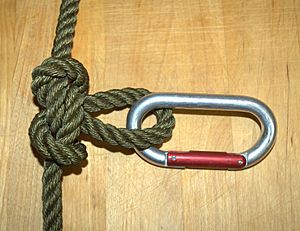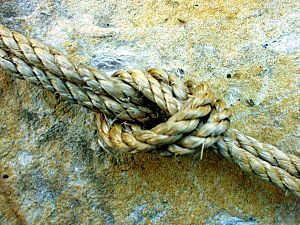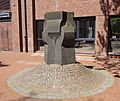Knot facts for kids
A knot is a way to tie a piece of string, rope, or other flexible material into a fixed loop or shape. People often use knots to connect things, hold them together, or even just for decoration. While we usually think of knots with ropes, you can tie a knot with many other things too! For example, your hair can get tangled in a knot, or you tie the end of a balloon to keep the air inside.
Most people over five years old know how to tie a knot. You probably tie knots every day when you do your shoelaces! Ribbons are also tied in pretty knots when they are wrapped around a gift.
Sailors use many different kinds of knots for various jobs on ships. Some people even enjoy tying knots as a hobby! There are so many different knots, and each one is good for a specific task. Some knots help you attach a rope to another object, like a ring or a stake. Other knots are used to hold or squeeze objects tightly. Decorative knots are tied to themselves to create cool patterns.
In its simplest form, a knot can be a stopper at the end of a rope. This stops the rope from slipping through a hole. People have been interested in knots for a very long time. They are useful, and they can be quite tricky, which is why they are even studied in a part of mathematics called knot theory.
Useful Knots You Can Learn
Here are some common and helpful knots:
- Alpine butterfly knot: This knot makes a strong loop in the middle of a rope. It's great when the ends of the rope are not free.
- Bowline: This knot creates a loop at the end of a rope. It's often used around someone's waist or to attach to a ring. Sailors and climbers use it a lot.
- Constrictor knot: Use this knot to tie bundles or close the top of a bag. Be careful, though, as it can get very tight and might need to be cut to undo it.
- Figure-eight knot: This is a simple knot used as a stopper. It keeps a rope from slipping through a hole.
- Grass bend: This knot is good for tying belts together. However, it's not very secure with ropes.
- Monkey's fist: This knot adds weight to the end of a rope. It's often used to throw a line a long distance.
- Prusik: This knot is used to climb up a rope. It slides when loose but grips tightly when weight is put on it.
- Reef knot (also called a square knot): This is a common knot for joining two ends of a rope around an object. It's easy to tie but can come undone if not tied correctly.
- Sheet bend: This knot is used to join the ends of two ropes. It works well even if the ropes are different thicknesses.
- Double sheet bend: This is an even stronger version of the sheet bend, perfect for tying two ropes of very different sizes together.
- Spanish bowline: This knot creates two loops. It's often used to lift people up or lower them over the side of a ship.
- Versatackle: This knot helps you lift heavy things or tighten ropes on a ship.
- Water knot: This knot is best for tying flat materials, like nylon webbing, together.
Related pages
Images for kids
-
An example of a quipu from the Inca Empire, currently in the Larco Museum Collection.
-
Alexander cuts the Gordian Knot, by Jean-Simon Berthélemy (1743–1812)
-
Magimagi sennit of Fiji around wooden ceiling posts.
-
Blackfoot "Teton" tipi tie
See also
 In Spanish: Nudo (lazo) para niños
In Spanish: Nudo (lazo) para niños
















